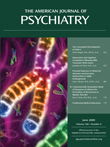Validation and Extension of the Endophenotype Model in ADHD Patterns of Inheritance in a Family Study of Inhibitory Control
Abstract
Objective: Endophenotypes, markers of underlying liability to psychiatric disorders, can improve the power to detect genetic risks relative to a complex clinical endpoint. Motor response inhibition is a prime candidate endophenotype in ADHD. In this study, the authors sought to extend the endophenotype model and further demonstrate its utility by investigating the parental origin of shared genetic risk in ADHD. Method: Inhibitory control was studied in children with ADHD, unaffected siblings, and their biological parents. Covariation in inhibitory control within families was investigated. Differential covariation as a function of parental sex was also studied. A number of validity criteria for inhibitory control as an endophenotype were assessed, including sensitivity to the disorder and presence in unaffected relatives. Results: The results confirmed an inhibitory control deficit in children with ADHD as well as in their parents, independent of symptom severity in both generations. Inhibitory control ability in children was significantly predicted by the ability of their parents, particularly their fathers. Conclusions: These findings indicate that an inhibitory control deficit is a cognitive marker of genetic risk shared by parents and offspring. The endophenotype model is also extended by evidence of differential parental contributions to this risk, consistent with findings of parent-of-origin effects in the transmission of certain risk alleles observed in molecular analyses. The identification of these effects at the endophenotype level and their incorporation in genetic modeling can improve both linkage detection and localization of quantitative trait loci.



